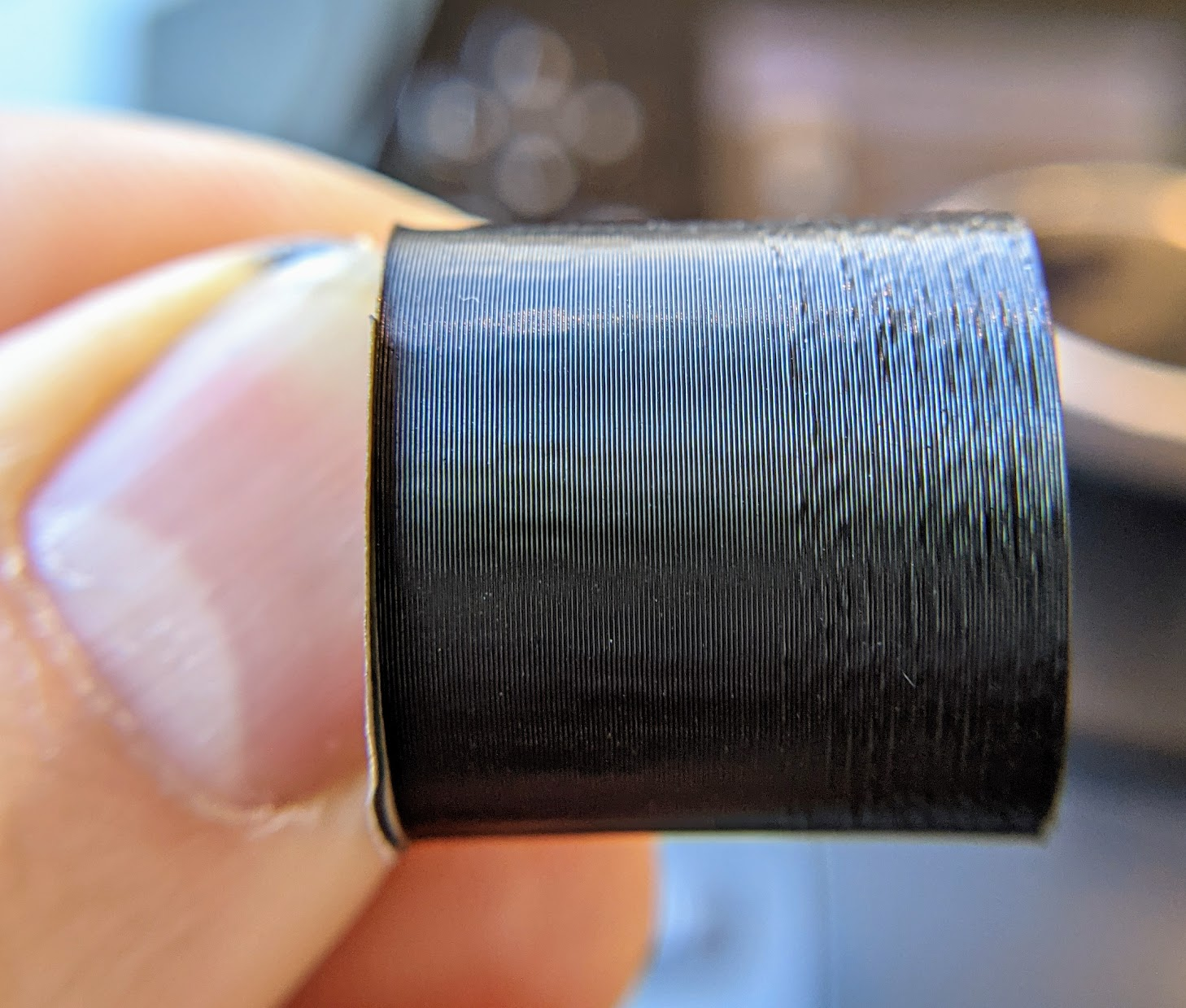Duet Maestro Struggling to Produce Smooth Curves
-
Look like about 10mm radius then. The segment length used by RRF 3.2 is:
length = min(sqrt(8 * radius * 0.02), speed/50)
subject to a minimum of 0.1mm and a maximum of 2.0mm. Putting your figures in, at 60mm/sec we get:
length = min(sqrt(1.6), 1.2)
so the minimum segment length will be 1.2mm. Does this fit with what you observed?
The Maestro has no hardware floating point unit, so there is limited scope to use smaller segments. However, the arc generation algorithm has been speeded up somewhat in the 3.3beta source code, so there may now be some scope.
-
1mm does match up to the faceting I am seeing there.
So RRF is taking the arc and decomposing them back into line segments to drive motion? Somewhat counter productive, if I can already output sub 1mm segments from the slicer. I was hoping that the arcs could help to avoid the segment junction issue, by making them tangent, but it appears to by making them worse in this case.
-
As far as I recall as processors/boards get faster, in the future, the integrated line-segmentation will overtake one day by beeing faster and finer by dirctly controlling the motor (in the long run...)... If you ask me if the duet-community does not want the hardware to be considerably more expensive (I don´t want that) we have to wait until our price-segment cpu etc. get´s faster...
I stay with pre-segmentation in the post-processor til that day
 because a hot plastic-stripe is anyhow far from being perfect
because a hot plastic-stripe is anyhow far from being perfect 
Hope that is of any help
 & great post - because thanks to you dc42 posted the formula
& great post - because thanks to you dc42 posted the formula 
-
@LB said in Duet Maestro Struggling to Produce Smooth Curves:
As far as I recall as processors/boards get faster, in the future, the integrated line-segmentation will overtake one day by beeing faster and finer by dirctly controlling the motor (in the long run...)... If you ask me if the duet-community does not want the hardware to be considerably more expensive (I don´t want that) we have to wait until our price-segment cpu etc. get´s faster...
I stay with pre-segmentation in the post-processor til that day
 because a hot plastic-stripe is anyhow far from being perfect
because a hot plastic-stripe is anyhow far from being perfect 
Hope that is of any help
 & great post - because thanks to you dc42 posted the formula
& great post - because thanks to you dc42 posted the formula 
I don't think this is a hardware limitation. The Maestro can already chug through super dense code to approximate curves with smooth motion. It would be far less taxing on the hardware to use motion planning that allowed path deviations to virtually erase these segment vertices, and not rely on jerk (not a trivial coding task though).
Is anything like that planned @dc42?
-
@CCS86 said in Duet Maestro Struggling to Produce Smooth Curves:
It would be far less taxing on the hardware to use motion planning that allowed path deviations to virtually erase these segment vertices, and not rely on jerk (not a trivial coding task though).
Essentially you are askling RRF to second guess that the user wanted a curve, not facets. IMO that's the wrong approach. Jerk does not produce facets, it merely allow them to be printed without slowing down at each junction.
The correct approach is for the input GCode to have either facets too fine to see, or not gacets at all and G2/G3 curves instead. The focus of RRF should be to be able to print those curves without visible facets. As it happens, I already did some work in RRF 3.3 to make the computations more efficient, which will allow finer segmentation of curves. If you wish, you can try out a 3.3 internal build and we can work together to establish how fine we can make the segments.
-
That's a fair point for sure. Inferring the user intention is very difficult.
One approach could be to only allow this "path smoothing" on segments below a certain length threshold and below a certain angular separation; both user defined, along with the max deviation. It seems like this would put the user firmly in control.
I'm happy to do some testing on 3.2 vs 3.3. I actually haven't managed to choke 3.2 yet, so that would be the first order of business!
-
@dc42 Does the firmware use a finer G2/G3 arc segment for Duet boards with better calculation capacity?
I'm working with G2/G3 segments on my Duet 2 Wifi and I can occasionally see fine facets in cylinders (occasionally as in when everything else worked well!).
-
@MJLew said in Duet Maestro Struggling to Produce Smooth Curves:
@dc42 Does the firmware use a finer G2/G3 arc segment for Duet boards with better calculation capacity?
I'm working with G2/G3 segments on my Duet 2 Wifi and I can occasionally see fine facets in cylinders (occasionally as in when everything else worked well!).
Currently, all boards use the same segment length. It would probably make sense to use finer segments on boards with floating point hardware.
-
Okay, it looks like I was able to choke the Duet Maestro with RRF3.2 at 95mm/s printing 0.17mm segments.
So, just about 560 segments per second.
Scheduled moves 97706, completed moves 97706, hiccups 0, stepErrors 0, LaErrors 0, Underruns [26740, 0, 19], CDDA state -1Added cylinder in Superslicer (20x20x20).
2 walls.
Speed varied every 2mm from 60mm/s - 112mm/s.
XY accel = 3000 mm/s/s.
XY jerk = 10 mm/s
-
Thanks, it looks like there is scope to increase the maximum segments/sec for G2/G3 moves then.
-
@dc42 said in Duet Maestro Struggling to Produce Smooth Curves:
Thanks, it looks like there is scope to increase the maximum segments/sec for G2/G3 moves then.
I'm guessing that on your end steps/sec might be more important, these are 0.9* steppers with the following configuration:
M92 X159.93 Y159.75 ; set steps per mm M350 X16 Y16 I1 ; configure microstepping with interpolation -
@CCS86 I have put new 3.3beta firmware builds with finer G2/G3 segmentation at https://www.dropbox.com/sh/ian1cpllo0oexzy/AACLMSPaWhTXSrGcMieHT2uoa?dl=0.
-
@ccs86 Hello, i think i have a similar problem with printing smooth curves. Have you solved this problem, and if so, how? Thanks
-
@_domaa said in Duet Maestro Struggling to Produce Smooth Curves:
@ccs86 Hello, i think i have a similar problem with printing smooth curves. Have you solved this problem, and if so, how? Thanks
I would suggest reading this whole thread. There is a lot of good info, not just one answer.
-
 undefined CCS86 referenced this topic
undefined CCS86 referenced this topic